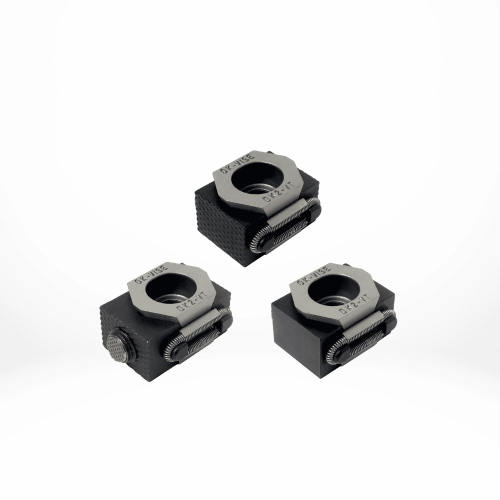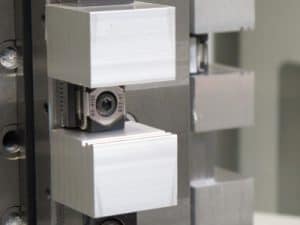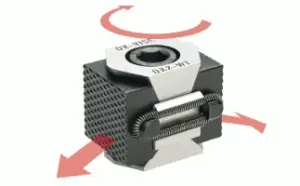A brief history of wedge operated workholding clamps.
In the late 1970’s, Finnish inventor and entrepreneur Mr. Olli Kytölä developed a new clamping method for workholding. The simplicity of the idea is mind-blowing even today: instead of moving large machine vise jaws against each other, a small wedge-operated jaw is pressing the workpiece against fixed stoppers. The clamp has two jaws, so possibility to clamp one or two workpieces with one clamp is built-in.
During last 40 years, this wedge operated workholding clamp has become famous with the name OK-VISE Low-Profile Clamp. The core application has always been in CNC milling, an in early days do-it-yourself people used to build their own workholding fixtures using OK-VISE clamps and milling the remaining parts of the milling fixture themselves.
How to use a low-profile clamp?
The clamping itself is very simple. When we are tightening the clamp, the wedge in the middle pushes the jaws sideways, pressing the workpiece against a fixed stopper.
Today the wedge operated clamp is widely used in machine shops all over the world due to its many benefits compared to normal vises. In our Fixturing Concept, the idea is to have locating components like stoppers, side guides and parallels as separate modules. These modules locate the workpiece, and clamps are used in most cases to clamp the workpiece against stoppers.
The clamping itself is very simple. When we are tightening the clamp, the wedge in the middle pushes the jaws sideways, pressing the workpiece against a fixed stopper.
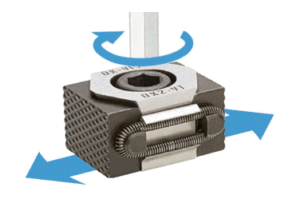
In addition to dedicated workholding, the low-profile clamp is often used in modular workholding systems, such as Multi-Rail RM. This approach, involving standardized modules for fixture designers and fixture builders, speeds up fixture sourcing radically, especially if a modular base rail is in use. Best-case scenario is that no machining at all is needed to build a new fixture.
Different clamp models
When we are talking about clamping the workpiece securely and safely for machining, it is important to look at various clamp models and their strengths.
The features of the machining process and the workpiece typically determine the requirements for the clamp. In most fixtures, so called force-closure is being used. This means that typically 3 sides of the workpiece have free access to milling tool, and holding force opposing the machining forces is created by friction.
When dealing with high forces during machining in force-closure fixtures more friction is needed between the jaw and the workpiece. This can be achieved by selecting a larger clamp (for bigger forces) or a model with enhanced grip for better friction compared to a smooth-jaw clamp.
Luckily, you can find a range of clamp options from us to securely attach even the most challenging workpieces.
Here we have couple of clamp model examples:
For better friction:
Tungsten carbide coated jaws are extremely useful when no clamping marks are allowed in the workpiece, yet high holding force is required to hold the workpiece. With tungsten carbide coating the holding force is about double compared to traditional smooth jaws. it has to be noticed that the marks that these jaws leave to the workpiece are almost invisible.
Serrated jaws are used when even higher holding forces are needed. When tightened with high force the serration penetrates into the workpiece, creating high friction.
For complicated shapes:
Sometimes the workpiece has a complex shape, which we need to consider when selecting the right clamp. In these cases, the clamp can have an adjustable jaw, or the jaw itself can be machined to match the shape of the workpiece.
Self-adjustable model is a great option when the workpiece has irregular shapes. These clamps have a self-adjustable ball pressure screw inserted into a clamp jaw which can adjust by the shapes of the workpiece.
Direction of the jaw movement
In mostly used the jaw slides along the fixture base. These are called hold-down models, because the wedge design holds the jaw down and prevents the jaw from lifting up while clamping.
The other option are pull-down models, where the jaw moves also towards the fixture base. When clamping the workpiece with this type of clamp, the workpiece is also pressed down. Another advantage is that with this clamping technology, we can achieve even higher clamping force, up to 15 kN.
Friction in low-profile clamp fixtures.
..more typical application is force-closure, where the friction between the workholding clamp and stopper jaws create a holding force that prevents the workpieces from moving.
One way to build a workholding fixture is form-closure, where the geometry of the layout prevents the workpieces from moving.
Another and more typical application is force-closure, where the friction between the workholding clamp and stopper jaws create a holding force that prevents the workpieces from moving. In most typical application there are 2 workholding clamps and 2 stoppers, each with the same force clamping the workpiece. When this force is multiplied by friction coefficiency µ, then we can calculate the holding force, in the abovementioned example.
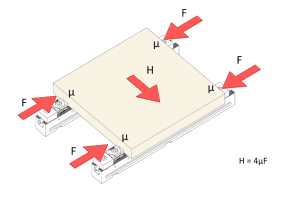
H = 4 µ F
where F is the clamping force, and friction coefficient varies. Example values when workpiece from steel is in use.
µ = 0,15 smooth jaws
µ = 0,28 tungsten carbide coated jaws
µ = 0,8 serrated jaws
What we have learned
All in all, using a wedge operated clamp is one of the easiest and best ways to build workholding fixtures. Its operation allows you to use it for clamping multiple workpieces simultaneously or when you need a high clamping force in limited space. For more details about our low-profile clamp, we have gathered product information in our instructions.
